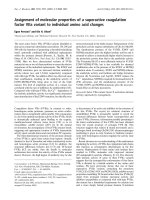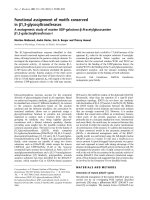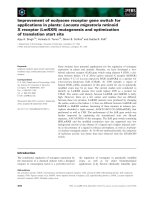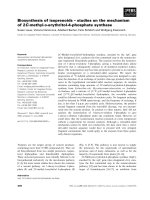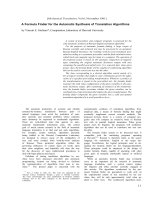assignment of translation studies
Bạn đang xem bản rút gọn của tài liệu. Xem và tải ngay bản đầy đủ của tài liệu tại đây (665.25 KB, 14 trang )
<span class="text_page_counter">Trang 1</span><div class="page_container" data-page="1">
<b>THANG LONG UNIVERSITYENGLISH DEPARTMENT</b>
<b>---o0o---ASSIGNMENT OF</b>
<b>TRANSLATION STUDIES</b>
<b>HA NOI – 2019</b>
</div><span class="text_page_counter">Trang 2</span><div class="page_container" data-page="2"><b>Table of Content</b>
<b>CHAPTER I. THEORY...3</b>
<i><b>1.1What is translation?... 3</b></i>
<i><b>1.2Types of translation:...3</b></i>
<i><b>1.3The process of translation:...4</b></i>
<b>1.3.1 The textual level...4</b>
<b>1.3.2 The referential level...4</b>
<b>1.3.3 The cohesive level...5</b>
<b>1.3.4 The level of naturalness...7</b>
</div><span class="text_page_counter">Trang 3</span><div class="page_container" data-page="3"><b>CHAPTER I. THEORY</b>
<b>1.1 What is translation?</b>
The process of translation between two different written languages involves the changing of an original written text (the source text or ST) in the original verbal language (the source language or SL) into a written text (the target text or TT) in a different verbal language (the target language or TL):
in source language(SL) in target language (TL)
(Jeremy Munday) Example:
SL: Mất bao lâu để bạn đi từ nhà đến chỗ làm?
TL: How long does it take you to get from home to work?
<i><b>1.2</b></i> <b>Types of translation: </b>
<b>Intralingual translation , or ‘rewording’ – ‘an interpretation of verbal </b>
signs by means of the same language’
E.g: We produce a summary in English of the novel Gone with the Wind.
<b>Interlingual translation, or ‘translation proper’ – ‘an interpretation of </b>
verbal signs by means of other language’
E.g: When translating a product manual from Vietnamese into English and the ST is Vietnamese, the TT is English.
<b>Intersemiotic translation, or ‘transmutation’ – ‘interpretation of verbal </b>
signs by means of signs of non-verbal signs systems’ E.g: ST – The movie Harry Porter and the Order of the Phoenix.
TT – The novel named Harry Porter
(Jeremy Munday)
</div><span class="text_page_counter">Trang 4</span><div class="page_container" data-page="4"><i><b>1.3</b></i> <b>The process of translation:</b>
1.3.1 The textual level
When working on the text level: - You create certain ‘conversions’ intuitively:
+ transpose the SL grammar -> their “ready” TL equivalents
+ translate the lexical units -> sense that appears immediately appropriate The base level when you translate is <i><b>the text level</b></i>.
- The level of the literal translation of the source language into the target language.
- The level of the translation you have to eliminate
- A corrective of paraphrase and the pared-down of synonyms.
1.3.2 The referential level
Every sentence in a SL need to be seen on <i><b>the referential level</b></i>.
Example: In Vietnamese-English translation, if someone says “Thầy tôi đang đang ngủ.” what he or she means was “My dad is sleeping”. Without proper referential level, the sentence can be mistranslated into “My teacher is sleeping” based on general English grammar.
The referential level goes hand in hand with the textual level. The textual level: Language of source text convey message
The referential level: Use language to decode the message to find real meaning
The translator mentally sorts out the text
- decode the meaning of the source text and build the conceptual representation
- figure out the message, semantic of the source text
</div><span class="text_page_counter">Trang 5</span><div class="page_container" data-page="5">- build up the referential picture in your mind when you transform the SL into the TL text
E.g: “Cây gạo đại thu trồng năm 1284 – Giáp Thân” is translated into “Plant rice university acceptance – planted 1284 – Armor Body” instead of “The prennial bombax ceiba or The giant bombax ceiba – planted in 1284 (Year of the Monkey).
For each sentence, when it is not clear, when there is an ambiguity, when the writing is abstract or figurative, you have to supplement the linguistic level, the text level with the referential level, the facts of the matter with the necessary additional information
Translator have to make up his/her mind, ask themselves, imagine an image to find the real intention of writer behind words
Once you have decoded ST, you encode it into an appropriate language expression.
1.3.3 The cohesive level
The cohesive level links the <i>textual</i> and the <i>referential levels (a more</i>
“generalized” level that links the first and the second level) It follows both the STRUCTURE and the MOOD of the text
<b>o STRUCTURE</b>
<i>- Through connective words (conjunctions, enumerations, reiterations,definite article, general words, referential, synonyms, punctuationmarks) linking the sentences, proceeding from known information(theme) to new information (rheme)</i>
- Follow the train of thought; there is a sequel, a sequence of time, space, and logic in the text
E.g:
<b>Borrowing Money</b>
</div><span class="text_page_counter">Trang 6</span><div class="page_container" data-page="6">- Glad to see you, old man. Can you lend me five dollars? - Sorry, but I haven't a cent with me today.
- And at home?
- They're all very well, thank you, very well.
<b>Vay tiền</b>
- Rất vui được gặp anh, anh bạn. Cho tôi vay mười đô được không? - Tiếc quá! Hôm nay tơi khơng có một xu trong người.
- It means tracing the thread of a text through its laden and value-free passages which may be expressed by objects, nouns & adjectives For example:
• awesome and amazing • passed away and died
- It makes difference in words in a particular language whose value cannot always be determined in the context.
- Thought through the connectives and the feeling tone may determine the difference between a humdrum or misleading translation and a good one.
</div><span class="text_page_counter">Trang 7</span><div class="page_container" data-page="7">- The cohesive level is a regulator, it secures coherence, it adjusts emphasis.
1.3.4 The level of naturalness
For all texts, for the vast majority of texts, you have to ensure that: - Your translation makes sense
- It reads naturally, that it’s written in ordinary language, the common grammar, idioms and words that meet that kind of situation
Normally, you can only do this by temporary disengaging yourself by reading your own translation as though no original exists.
You have to make that passage sound natural, which will usually depend on the degree of formality you have decided on for the whole text.
When you faced with an innovatory expressive text, you have to try to gauge the degree of its deviation from naturalness, from ordinary language and reflect this degree in your translation. Thus, in translating any type of text you have to sense naturalness, usually for the purpose of deviating from naturalness.
You have to bear in mind that the level of naturalness of natural usage is grammatical as well as lexical (i.e. the most frequent syntactic structures, idioms and words that are likely to be appreciate sentence connectives, may extend to the entire text.
Naturalness is easily defined as, not so easy to concrete about. Natural usage comprises a variety of idioms or styles or registers determined primarily by the setting of the text i.e. where it is typically published or found, secondarily by the author, topic and readership, all of whom are usually dependent of the setting. Natural usage, then, must be distinguished from” ordinary language”
For example: Take any article in Foreign Trade Moscow.
</div><span class="text_page_counter">Trang 8</span><div class="page_container" data-page="8">You have to pay special attention to: Word order;
For example: He plays baseball on Monday. On Monday, he plays baseball.
Common structures;
For example: Dạo này bạn thế nào? How are you? (unnatural)
How is it going? (natural)
controversy: controversia (Spanish); root: controversus (Latin)
The appropriateness of gerunds, infinitives, ver-nouns;
For example: the establishment of, 'establishing', 'the establishing of, to establish
For example: white face and black eyes (unnatural) Beautiful shinny face and dark eyes (natural)
Other “obvious” areas of interference.
For example: correct English (unnatural) – proper English (natural) (Peter Newmark)
</div><span class="text_page_counter">Trang 9</span><div class="page_container" data-page="9"><b>1.4 Equivalence:</b>
1.4.1 Definition:
It is the relationship between a ST and a TT that allows the TT to be considered as a translation of the ST.
Equivalence is a relationship between two texts in two languages, rather than between the languages themselves
1.4.2 Types of Equivalence:
<b>Denotative equivalence, related to equivalence of the extralinguistic</b>
content of a text. Other literature, says Koller, calls this ‘content invariance’.
<b>Connotative equivalence, related to lexical choices, especially between</b>
near-synonyms. Koller considers this type of equivalence to be referred to by others as ‘stylistic equivalence’.
<b>Text-normative equivalence, related to text types, with different kinds of</b>
texts behaving in different ways. This is closely linked to work by Katharina Reiss.
<b>Pragmatic equivalence, or ‘communicative equivalence’, is oriented</b>
towards the receiver of the text or message. This is Nida’s dynamic equivalence.
<b>Formal equivalence, which is related to the form and aesthetics of the text,</b>
includes wordplays and the individual stylistic features of the ST. It is referred to by others as ‘expressive equivalence’ and should not be confused with Nida’s term ‘formal equivalence’.
Example: SL:
Bèo giạt về đâu, hàng nối hàng; Mênh mơng khơng một chuyến đị ngang. Khơng cầu gợi chút niềm thân mật,
</div><span class="text_page_counter">Trang 10</span><div class="page_container" data-page="10">Lặng lẽ bờ xanh tiếp bãi vàng. TL:
Bèo drift about where, line connection; Vast not a ferry across.
No need to suggest little intimacy,
Quietly the green shore next to the gold beach. (Tràng Giang – Huy Cận)
(Jeremy Munday)
<i><b>1.5</b></i> <b>Translation and Culture:</b>
1.5.1 Definition
Culture as the way of life and its manifestations that are peculiar to a community that uses a particular language as its means of expression.
More specifically, distinguish 'cultural' from 'universal and 'personal language.
Example: Universal - 'Die, 'live, 'star','swim'
Personal - 'Monsoon, 'steppe, 'dacha','tagliatelle’
Contrast: universals, i.e. general aspects of nature and humans and their physical and mental activities; numbers and dimensions
Distinguish: cultural focus, distance (or gap) and overlap
1.5.2 Cultural categories:
<b>(1) Ecology</b>
Flora, fauna, winds, plains, hills: 'honeysuckle', 'downs', 'sirocco', *rundra\ 'pampas', tabuleiros (low plateau), 'plateau', selva (tropical rain forest), 'savanna','paddy field*
<b>(2) Material culture (artefacts)</b>
</div><span class="text_page_counter">Trang 11</span><div class="page_container" data-page="11">(a) Food: 'zabaglione', 'sake', Kaiserschmarren
(b) Clothes: 'anorak', kanga (Africa), sarong (South Seas), dhoti (India) (c) Houses and towns: kampong, bourg, bourgade7 'chalet', 'low-rise', 'tower' (d) Transport: 'bike*, 'rickshaw', 'Moulton', cabriolett'tilbury', caliche (3) Social culture - work and leisure ajaki amah, condotttere, biwa, sithar, raga, 'reggae', 'rock'
<b>(4) Organisations, customs, activities, procedures, concepts</b>
(a) Political and administrative (b) Religious: dharma, karma? 'temple' (c) Artistic
<b>(5) Gestures and habits</b>
'Cock a snook','spitting'
(Peter Newmark)
</div><span class="text_page_counter">Trang 12</span><div class="page_container" data-page="12"><b>CHAPTER II. PRACTICESource Language:</b>
Cacao trees are 4-8 m tall and grow well under the shade of other trees, and so are often intercropped with coconut and rubber. Ripe cacao fruits are yellow, orange or red. Its seeds yield comfort foods like chocolate and cocoa butter.
After harvesting ripe cacao pods, the farmers put them in a box and cover it for a day or two for the fruits to acclimate. Then their husk is removed.
The cacao fruit has white pulp which tastes sour. It turns bitter after being processed. The pulp is incubated for six to seven days after which the fermented pulp detaches from the beans inside. The fermentation process is very important to ensure the seeds' quality.
<b>Target Language (Google translate)</b>
Cây ca cao cao 4-8 m và phát triển tốt dưới bóng mát của những cây khác, và vì vậy thường được trồng xen với dừa và cao su. Quả cacao chín có màu vàng, cam hoặc đỏ. Hạt của nó mang lại thực phẩm thoải mái như sơ cơ la và bơ ca cao.
Sau khi thu hoạch vỏ quả cacao chín, nơng dân cho chúng vào một cái hộp và đậy nắp trong một hoặc hai ngày để quả được tích lũy. Sau đó, trấu của họ được loại bỏ.
Quả cacao có cùi trắng có vị chua. Nó biến thành vị đắng sau khi được chế biến. Bột giấy được ủ trong sáu đến bảy ngày sau đó bột giấy lên men tách ra từ đậu bên trong. Quá trình lên men là rất quan trọng để đảm bảo chất lượng của hạt giống.
<b>Comment and evaluate:</b>
- The above translation uses the Literal translation method because the Source Language grammar structures are converted to their nearest equivalent in Target Language but some words out of the context.
</div><span class="text_page_counter">Trang 13</span><div class="page_container" data-page="13">- Google translates “comfort foods” into “thực phẩm thoải mái”. It translates one word then combines the meaning of “comfort” and “foods” together. The word translated out of the context.
- The word “pulp” is not equivalent to in the target language. Pulp in Vietnamese means “thịt, cùi, lõi” but in Google translate, it turns to “bột giấy”.
- In source language, they have one word is “acclimate” which can be understood is being adapted. On the other hand, in target language it translates into “tích lũy” which means to gather, to accumulate.
- Also, in this situation “beans” is understood that the seeds of cacao tree, however, Google translates in “đậu” – the other food.
- The word “husk” when used with cacao trees means that the outside of the seed but in target language it means “trấu” which usually uses for the outside of rice.
- Vietnam also has cacao tree, chocolate or cocoa butter like others countries so it is not difficult for Google to translate this word.
</div><span class="text_page_counter">Trang 14</span><div class="page_container" data-page="14"><b>REFERENCES</b>
<b>(1) A textbook of translation – Peter Newmark</b><b>(2) The 3 edition Introducing translation studies – Theories and applications –</b><small>rd</small>
</div>
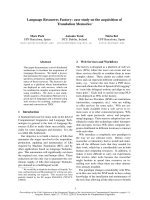
![Báo cáo khoa học: Assignment of the [4Fe-4S] clusters of Ech hydrogenase from Methanosarcina barkeri to individual subunits via the characterization of site-directed mutants pdf](https://media.store123doc.com/images/document/14/rc/do/medium_dor1394202044.jpg)
